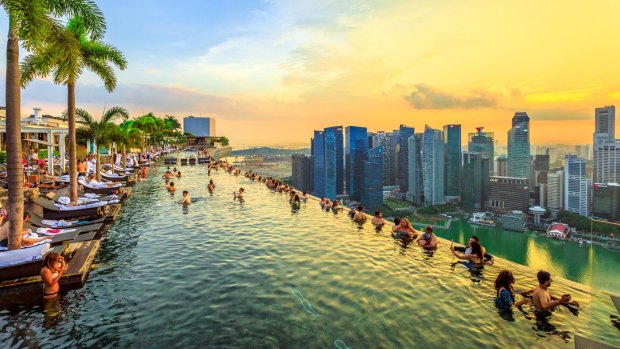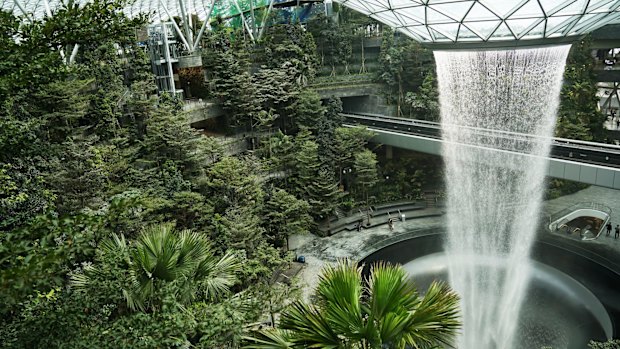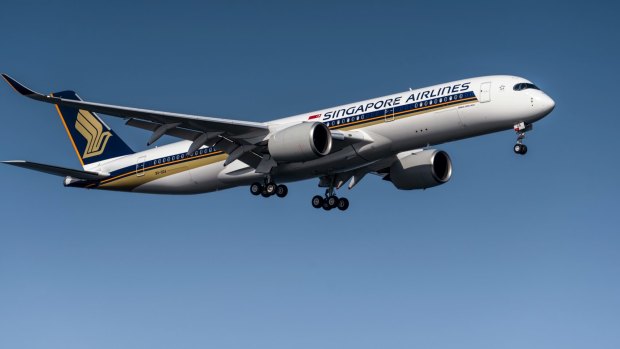This was published 4 years ago
Reopening Australia to international travellers after COVID-19 lockdown: Lessons Australia could learn from Singapore
By Michael Gebicki

Singapore - May 3, 2018: Infinity Pool at sunset of Skypark that tops the Marina Bay Sands Hotel and Casino from rooftop of La Vie Club Lounge on 57th floor. Financial district skyline on background. singaporeCredit: iStock
Singapore is embarking on a suite of controlled measures aimed at reopening the country to international travellers in a program that could provide a template for Australia's own re-emergence on the international travel scene.
While Singapore has been one of the countries least affected by the COVID-19 health crisis, with a death rate far lower than Australia's despite double the case numbers, the island-state's economy has been shattered. One of Asia's most successful entrepots, Singapore depends on trade and the free movements of goods and people, and the coronavirus has put a chokehold on both. According to the country's Ministry of Trade and Industry, Singapore's economy contracted by 42.9 per cent in the second quarter of 2020 compared to the previous quarter.
Singapore's tourism industry has not been spared. Tourist arrivals were just 9500 in September 2020. That's a drop of 99.4 per cent on the figure recorded in September 2019. Singapore is also one of Asia's dominant airline hubs. In 2019, 68.3 million passengers passed through Changi Airport, putting it in 18th place on the list of the world's busiest airports. Today Changi is seeing just 1.5 per cent of its normal passenger traffic and the airport has dropped from seventh to 58th place on the list of the world's busiest airports for international passenger traffic.

Credit: Bloomberg
In a speech to the Singapore Parliament on October 6, in which he described Singapore's Changi Airport as the city's lung, Minister for Transport Ong Ye Kung stated "Today, we have fewer passengers than when we first opened Changi Airport Terminal 1 in 1981." National carrier Singapore Airlines has cut 20 per cent of its workforce. To prevent more layoffs, in September Singapore Airline's re-employed captains agreed to salary cut of 60 per cent, and 50 per cent for first officers.
Singapore's strategic reopening
With caution at the forefront, Singapore has embarked on a pump-priming exercise, allowing in travellers from those countries with low rates of COVID-19, and under strict conditions.
Initially Singapore established Reciprocal Green Lane arrangements to allow business and official travellers to enter from Brunei, China, Indonesia, Japan, Malaysia and South Korea.
More recently, Singapore has opened the door a crack further to welcome leisure travellers. Singapore now allows residents of Australia, Brunei, Vietnam and New Zealand to apply for an Air Travel Pass (ATP).
The ATP allows any traveller from those countries to make a short-term visit to Singapore. In the case of Australian residents, apart from remaining in Australia for 14 days before departure for Singapore, submitting a health declaration and downloading Singapore's TraceTogether app to their smartphone, the main requirement is a polymerase chain reaction (PCR) test to be taken on arrival in Singapore, and a stay in isolation in pre-booked accommodation for up to two days awaiting the result of their test. The PCR test is the gold standard assessment for COVID-19, more accurate than an antigen test, but also slower and more expensive.
Residents of China were also eligible to apply for an ATP from November 6. Although China has grown into a huge market for Singapore with 3.63 million visitors in 2019, Singapore's tourist authorities are not expecting a rush of ATP applicants from China since, like Australia, China has strict quarantine restrictions for all incoming and returning travellers.
While extending the ATP program to other countries with low COVID-19 infection rates is a priority, Singapore is keen to reassure its populace that any inherent risk can be managed by braking the inflow of international travellers should circumstances require it, or even selectively denying entry to those coming from countries experiencing coronavirus flare-ups.
In another sign of Singapore's re-opening to the wider world, Singapore Airlines is resuming its non-stop flights between Singapore and New York City with a thrice-weekly service. On those flights, the world's longest, the airline will be using a standard Airbus A350 rather than the Airbus A350-900ULR variant, taking advantage of the former aircraft's greater cargo capacity. US residents are not included in the ATP or Green Lane programs, and therefore won't be aboard the SIA return flight to Singapore.

So far, the take-up of the ATP has been slow. As of October 27 the Civil Aviation Authority of Singapore had approved just 1375 ATP applicants, and none who arrived to that date had tested positive. For all but a tiny minority of Australian travellers, the ATP is a non-event since outbound travel is still subject to Australian government restrictions, and any returning traveller would be required to quarantine for 14 days.
The low number of ATP applications is no reason to be discouraged, according to Transport Minister Ong. "Notwithstanding this, such unilateral opening is still meaningful, because it is like a standing invitation. Although the other countries are not ready to lift their restrictions now, Singapore can be top of mind when they are ready eventually. But the most meaningful support we can give to our aviation companies is to restore passenger traffic and revive our air hub, in a safe, controlled manner. "
The Singapore experience could also serve as a model for the safe departure and return of Australian residents to foreign parts, without the requirement to undergo two weeks of quarantine on return. For those Singapore residents who travel overseas, depending on where they've been during their travels, they may be issued with a Stay-Home Notice (SHN) and required to take a PCR test upon return to Singapore. While the SHN is a requirement to self-isolate in their own home, it remains in force only until a negative result is obtained from the PCR test – a maximum of about two days.
If the Australian government wants to start opening the door to international travellers, allow its own residents to depart and return while protecting the health of the wider community and stop its outbound tourism industry from falling into the gutter and all its employees joining the ranks of the unemployed, it would do well to pay attention to Singapore in the days ahead.
See also: One of the world's longest flights set to return (and it will be even longer)
See also: Budget airlines need to die: Here's why
Sign up for the Traveller Deals newsletter
Get exclusive travel deals delivered straight to your inbox. Sign up now.